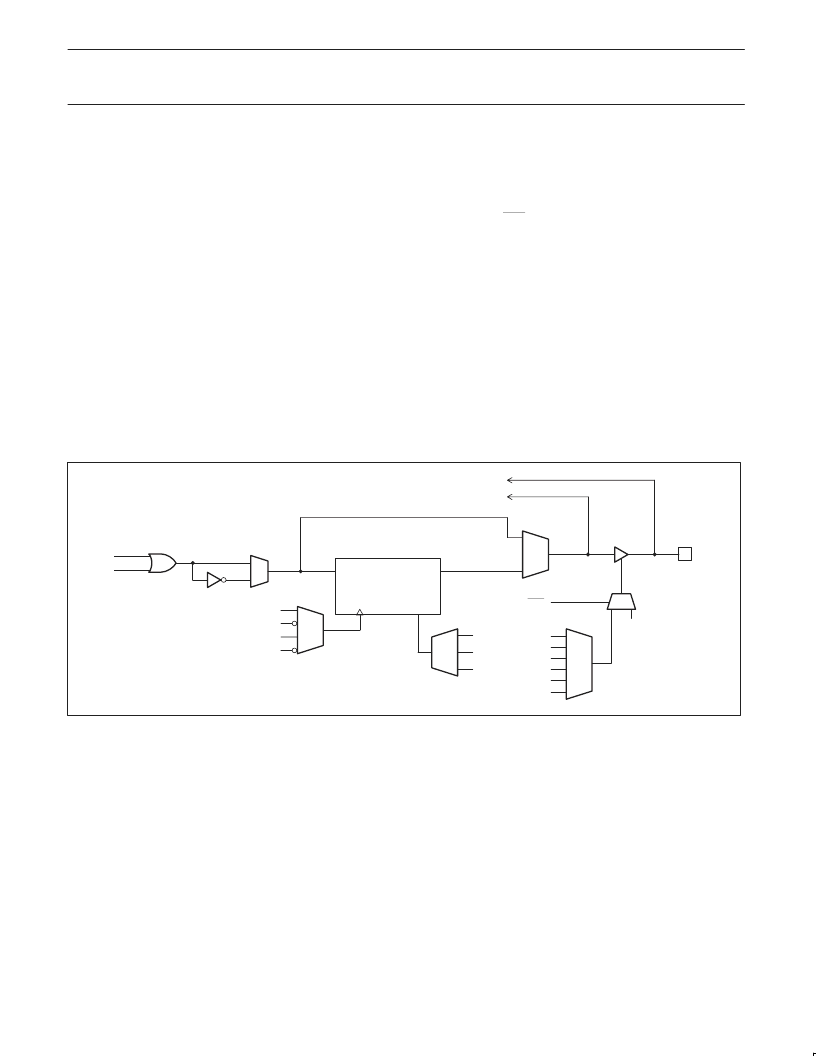- 您现在的位置:买卖IC网 > PDF目录368401 > PZ5032-6A44 Electrically-Erasable Complex PLD PDF资料下载
参数资料
| 型号: | PZ5032-6A44 |
| 英文描述: | Electrically-Erasable Complex PLD |
| 中文描述: | 电可擦除复杂可编程逻辑器件 |
| 文件页数: | 5/14页 |
| 文件大小: | 107K |
| 代理商: | PZ5032-6A44 |

Philips Semiconductors
Product specification
PZ5032
32 macrocell CPLD
1997 Feb 20
5
Macrocell Architecture
Figure 3 shows the architecture of the macrocell used in the
CoolRunner
family. The macrocell consists of a flip-flop that can be
configured as either a D or T type. A D-type flip-flop is generally
more useful for implementing state machines and data buffering. A
T-type flip-flop is generally more useful in implementing counters. All
CoolRunner
family members provide both synchronous and
asynchronous clocking and provide the ability to clock off either the
falling or rising edges of these clocks. These devices are designed
such that the skew between the rising and falling edges of a clock
are minimized for clocking integrity. There are 2 clocks (CLK0 and
CLK1) available on the PZ5032 device. Clock 0 (CLK0) is
designated as the “synchronous” clock and must be driven by an
external source. Clock 1 (CLK1) can either be used as a
synchronous clock (driven by an external source) or as an
asynchronous clock (driven by a macrocell equation).
Two of the control terms (CT0 and CT1) are used to control the
Preset/Reset of the macrocell’s flip-flop. The Preset/Reset feature
for each macrocell can also be disabled. Note that the Power-on
Reset leaves all macrocells in the “zero” state when power is
properly applied. The other 4 control terms (CT2–CT5) can be used
to control the Output Enable of the macrocell’s output buffers. The
reason there are as many control terms dedicated for the Output
Enable of the macrocell is to insure that all CoolRunner
devices
are PCI compliant. The macrocell’s output buffers can also be
always enabled or disabled. All CoolRunner
devices also provide a
Global Tri-State (GTS) pin, which, when pulled Low, will 3-State all
the outputs of the device. This pin is provided to support “In-Circuit
Testing” or “Bed-of-Nails Testing”.
There are two feedback paths to the ZIA: one from the macrocell,
and one from the I/O pin. The ZIA feedback path before the output
buffer is the macrocell feedback path, while the ZIA feedback path
after the output buffer is the I/O pin ZIA path. When the macrocell is
used as an output, the output buffer is enabled, and the macrocell
feedback path can be used to feedback the logic implemented in the
macrocell. When the I/O pin is used as an input, the output buffer
will be 3-Stated and the input signal will be fed into the ZIA via the
I/O feedback path, and the logic implemented in the buried
macrocell can be fed back to the ZIA via the macrocell feedback
path. It should be noted that unused inputs or I/Os should be
properly terminated.
CT2
CT3
CT4
CT5
V
CC
GND
INIT
(P or R)
D/T
Q
SP00440
CLK0
CLK0
CLK1
CLK1
TO ZIA
GND
CT0
CT1
GND
GTS
Figure 3.
PZ5032 Macrocell Architecture
相关PDF资料 |
PDF描述 |
|---|---|
| PZ5032-6BC | Electrically-Erasable Complex PLD |
| PZ5032-6BC-S | Electrically-Erasable Complex PLD |
| PZ5032-7(TBD) | ASIC |
| PZ5032-7A44 | Electrically-Erasable Complex PLD |
| PZ5032-7BC | Electrically-Erasable Complex PLD |
相关代理商/技术参数 |
参数描述 |
|---|---|
| PZ5128-S7BP | 制造商: 功能描述: 制造商:undefined 功能描述: |
| PZ-5-3 | 制造商:WM BERG 功能描述: |
| PZ5CG | 制造商:未知厂家 制造商全称:未知厂家 功能描述:0.5 KV ISOLATED 0.75 W REGULATED SINGLE OUTPUT SIP7 |
| PZ5CG-0505E | 制造商:未知厂家 制造商全称:未知厂家 功能描述:0.5 KV ISOLATED 0.75 W REGULATED SINGLE OUTPUT SIP7 |
| PZ5CG-0512E | 制造商:未知厂家 制造商全称:未知厂家 功能描述:0.5 KV ISOLATED 0.75 W REGULATED SINGLE OUTPUT SIP7 |
发布紧急采购,3分钟左右您将得到回复。